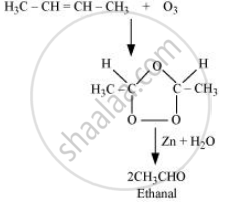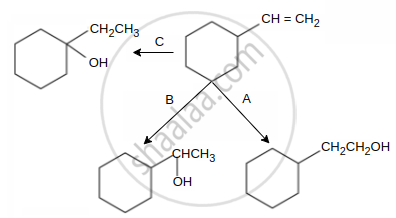Advertisements
Advertisements
प्रश्न
An alkene ‘A’ contains three C – C, eight C – H σ bonds and one C – C π bond. ‘A’ on ozonolysis gives two moles of an aldehyde of molar mass 44 u. Write IUPAC name of ‘A’.
उत्तर
As per the given information, ‘A’ on ozonolysis gives two moles of an aldehyde of molar mass 44 u. The formation of two moles of an aldehyde indicates the presence of identical structural units on both sides of the double bond containing carbon atoms. Hence, the structure of ‘A’ can be represented as:
XC = CX
There are eight C–H σ bonds. Hence, there are 8 hydrogen atoms in ‘A’. Also, there are three C–C bonds. Hence, there are four carbon atoms present in the structure of ‘A’.
Combining the inferences, the structure of ‘A’ can be represented as:
(A)
\[\begin{array}{cc}
\ce{H}\phantom{............}\ce{H}\\
|\phantom{.............}|\\
\ce{H - C - C = C - C - H}\\
|\phantom{....}|\phantom{....}|\phantom{....}|\\
\ce{H}\phantom{...}\ce{H}\phantom{...}\ce{H}\phantom{...}\ce{H}\end{array}\]
‘A’ has 3 C–C bonds, 8 C–H σ bonds, and one C–C π bond. Hence, the IUPAC name of ‘A’ is But-2-ene.
Ozonolysis of ‘A’ takes place as:

The final product is ethanal with a molecular mass
`=[(2xx12)+(4xx1)+(1xx16)]`
= 44 u
APPEARS IN
संबंधित प्रश्न
Write IUPAC name of the product obtained by the ozonolysis of the following compound.
Pent-2-ene
An alkene ‘A’ on ozonolysis gives a mixture of ethanal and pentan-3-one. Write structure and IUPAC name of ‘A’.
Propanal and pentan-3-one are the ozonolysis products of an alkene? What is the structural formula of the alkene?
Arrange the halogens F2, Cl2, Br2, I2, in order of their increasing reactivity with alkanes.
The addition of HBr to 1-butene gives a mixture of products A, B and C
| (A) |  |
| (B) |  |
| (C) | CH3 – CH2 – CH2 – CH2 – Br |
The mixture consists of:
Arrange the following hydrogen halides in order of their decreasing reactivity with propene.
Which of the following alkenes on ozonolysis give a mixture of ketones only?
| (i) | CH3 – CH = CH – CH3 |
| (ii) | \[\begin{array}{cc} \ce{CH3 - C - CH = CH2}\\ |\phantom{.......}\\ \ce{CH3}\phantom{....} \end{array}\] |
| (iii) |  |
| (iv) | \[\begin{array}{cc} \phantom{...................}\ce{CH3}\\ \phantom{..............}/\\ \ce{(CH3)2 C = C}\\ \phantom{..............}\backslash\\ \phantom{...................}\ce{CH3} \end{array}\] |
An alkene 'X' on ozonolysis produces two moles of isovaleraldehyde. Predict the IUPAC name of the alkene.
Which of the following reagent is used for the following reaction?
\[\ce{CH3CH2CH3 ->[?] CH3CH2CHO}\]
The major product formed in the following reactions is:


Select schemes A, B, C out of
(I) acid catalysed hydration
(II) HBO
(III) oxymercuration-demercuration
3-Methyl-pent-2-ene on reaction with HBr in presence of peroxide forms an addition product. The number of possible stereoisomers for the product is ______.
In the presence of peroxide, HCl and HI do not give anti-Markovnikov's addition of alkenes because ______.
An alkene ‘A’ contains three C – C, eight C – H σ bonds and one C – C π bond. ‘A’ on ozonolysis gives two moles of an aldehyde of molar mass 44 u. Write the IUPAC name of ‘A’.
